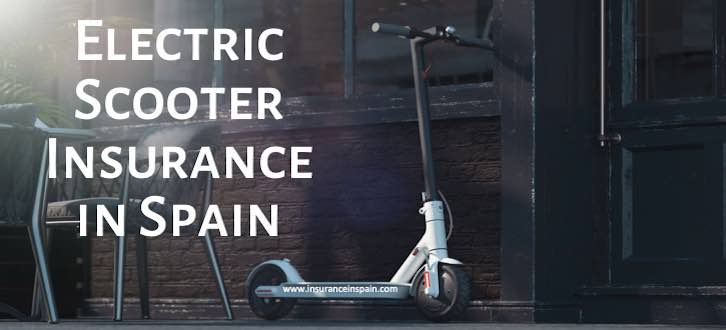Electric Scooter & Motorcycle insurances in Spain for Expats.
ELECTRIC SCOOTER - BICYCLE AND ELECTRIC VEHICLE INSURANCE IN SPAIN - IN ENGLISH
INSURANCE FOR ELECTRIC SCOOTERS & ELECTRIC MOTORCYCLES & VEHICLES IN SPAIN.
Electric Scooters in Spain.
Spain has seen a boom in electric scooters as well as an influx of hybrid and electric bicycles and motor vehicles. With the emphasis on all things electric, the demand is increasing. Its good for our planet and we all want to do what we can for emission controls.
Insuring your Electric scooter in Spain.
Insurance for your electric scooter is available through us, either as a single stand alone independent policy or we can add it to your house insurance policy. One of the advantages of having our house insurance policy with us is that we can add items like scooter insurance, bicycle insurance and such things as dangerous dog insurance in Spain onto your policy, often without any additional charges.
Scooter rules in Spain.
The older generation will remember the days when scooters were something convenient to nip down to the local shops on, or the kids would play with them in a relatively confined area. Nowadays, electric scooters can provide a range of many kilometres and they are being used more and more to travel longer distances and as a regular commuting tool.
This isn’t without safety issues and governments are looking to rush legislation to afford some rules of the road due to their sudden popularity. They are no longer a child’s plaything.
There are so many varieties of electric vehicles that they have, for the sake of creating a common law governing their use, been divided into different sections:-
1. Toys: Motorised hover boards and electric skates with a maximum speed of 6 KMPH can be used on pavements and pedestrian areas.
2. Mobility Scooters: Called VMP’s in Spain, (Vehiculos de Movilidad), Electric Scooters, Monocycles and Segways with a maximum speed of 25 KMPH can be used on authorised bike and cycling lanes, but never on pavements or any pedestrian areas.
3. Electric Bicycles: Permitted on public roads and the authorised bike lanes but not permitted on pavements and/or pedestrian areas.
4. Electric vehicles with speeds over 45 KMPH(Category L1E) can travel on all roads and are not permitted on pavements or pedestrian areas.
5. Pedal Cycles with Electric assistance commonly referred to as EPAC vehicles, (Electronically Power Assisted Cycles) do not come under the L1E category, so they do not need Homologation, but will require CE certification.
VIN numbers for electric Vehicles in Spain.
It is proposed that both electric bicycles and mobility scooters will require a VIN (vehicle identification number) similar to boats and motor cars as well as the ECC, European Community Certification, that must be supplied by the manufacturer. This is to insure that production and safety measures are up to the required European Standards.
Mobility scooters, Electric bikes and bicycles that can attain a speed of 45 KMPH or more will come under the same laws as petrol Scooters up to 50CC. The rider will require the Spanish AM category licence.
What is an AM category driving licence in Spain?
Drivers must be at least 15 years oldto obtain the Spanish AM category licence,which can be used for mopeds up to 50 cc and will be the licence applied to mobility and electric scooters and bicycles that can exceed 45 KMPH.
To avoid this category, it is likely that manufacturers will take note and make electric vehicles that do not exceed 45 KMPH to avoid the necessity of buyers having to obtain this licence, wear crash helmets and require statutory insurance.
These laws have not yet, as of September 2019, come into force, but they are something to consider if you are thinking of buying an Electric Scooter in Spain.
Wearing Crash Helmets on E-Scooters in Spain.
Like conventional bicycles and mopeds, it is always wise to wear a crash helmet for your own safety. Under the law, mopeds require the wearing of a certified crash helmet.
WithE-scooters, it may be, once the law is approved, that you may be required to wear a crash helmet. Whether this crash helmet is the motorcycle type or whether they will permit the conventional helmet that cyclists wear, as cyclists can attain very high speeds in excess of 80 KMPH and the lighter, ventilated type of crash helmet, may be approved for the vehicle in the L1E category,
EPAC, electronically powered assisted cycles, are designed so that the electric motor will assist you up to a maximum designated speed, about 25 KMPH before the electric motor automatically switches off. This does permit the rider to exceed this speed by pedal power alone and therefore they are still classified as cycles or bicycles. These vehicles, according to the latest update from the DGT, the Director General de Traffico, do not require registration, ITV’s (similar to the UK MOT) or insurance.
ITV for E-Scooters.
For both categories you will need a driving licence, registration, insurance and regular, probably annual ITV tests and you will be required to wear a crash helmet. The ITV is similar to a vehicle MOT in The UK.
Insuring your E-Bike or Scooter in Spain?
Regardless of the law, if you were going to use your E-scooter in Spain on any public road or in any public place we would recommend that you have insurance for your scooter in Spain. Better to be safe than sorry.

